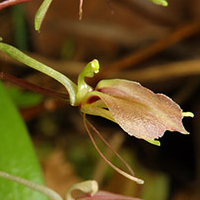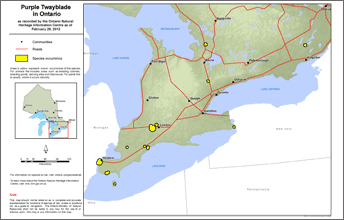Purple twayblade
Scientific name: Liparis liliifolia

Cover photo credit: Allen Woodliffe
Status
Threatened
“Threatened” means the species lives in the wild in Ontario, is not endangered, but is likely to become endangered if steps are not taken to address factors threatening it.
Date added to the Species at Risk in Ontario List
The Purple twayblade was already assessed as threatened when the Endangered Species Act took effect in 2008.
Read the assessment report
What it looks like
Purple twayblade is a small orchid that can grow to 25 centimetres tall. It has two broadly elliptical, toothless, shiny green leaves at the base of the plant and a single straight green or purplish tinged stem.
Five to 30 flowers grow along the stem and are clustered towards the tip. The petals are green to mauve-purple and the lower lip of the orchid flower is decorated with a network of reddish-purple veins.
Where it lives
In Ontario, Purple twayblade is found in a variety of habitats including open oak woodland and savannah, mixed deciduous forest, shrub thicket, shrub alvar, deciduous swamp, and even conifer plantations.
It will grow in partial shade, but does not like dense shade and depends on natural disturbances, such as storms and fire, to keep its habitat relatively open and sunny.
Where it’s been found in Ontario
In Canada, Purple twayblade is found primarily in southwest Ontario. Two additional populations are known from farther east, one in the Regional Municipality of York and the second in Frontenac County near Kingston.
Based on field surveys undertaken from 2007 to 2009, the Canadian population of Purple Twayblade is estimated at 200 to 500 plants in any given year within up to 19 distinct populations.
View a larger version of this map (PDF)
What threatens it
The main threat to Purple twayblade is habitat loss and alteration, development, and the growth of trees and shrubs that increase shade beyond what this species can tolerate.
Some populations may be threatened by browsing White-tailed deer and by competition from invasive plants such as Scots pine, European buckthorn and Garlic mustard.
Action we are taking
Threatened Species and their general habitat are automatically protected.
Recovery strategy
A recovery strategy advises the ministry on ways to ensure healthy numbers of the species return to Ontario.
Read the executive summary and the full document (July 22, 2019)
Government response statement
A government response statement outlines the actions the government intends to take or support to help recover the species.
Read the government response statement (April 23, 2020)
Habitat protection
General Habitat Protection - June 8, 2011
What you can do
Report a sighting
Report a sighting of an endangered animal or plant to the Natural Heritage Information Centre. Photographs with specific locations or mapping coordinates are always helpful.
Volunteer
Volunteer with your local nature club or provincial park to participate in surveys or stewardship work focused on species at risk.
Be a good steward
- private land owners have a very important role to play in species recovery; if you find Purple twayblade on your land, you may be eligible for stewardship programs that support the protection and recovery of species at risk and their habitats
- invasive species seriously threaten many of Ontario’s species at risk; to learn what you can do to help reduce the threat of invasive species, visit:
- Purple twayblade and many other species at risk depend on healthy grassland prairies, a rare habitat in Ontario; learn more about these habitats, the species that depend on them, and what you can do to help.
- pollinators, such as bees, are in steep decline across the globe and they play a key role in the survival of many of Ontario’s rare plants; for information on how you can help scientists monitor pollinator populations in Ontario visit Seeds of Diversity
Report illegal activity
Report any illegal activity related to plants and wildlife to
Quick facts
- Purple twayblade often grows in grassland savanna – one of the most endangered habitats in Canada; this extremely rare community supports an amazing diversity of wildlife, plants, butterflies and other insects
- Fire plays a key role in maintaining the savanna habitat where the Purple twayblade lives; fire stimulates the growth of these hardy prairie flowers and naturally removes many trees and shrubs that would otherwise take over through a process called natural succession
